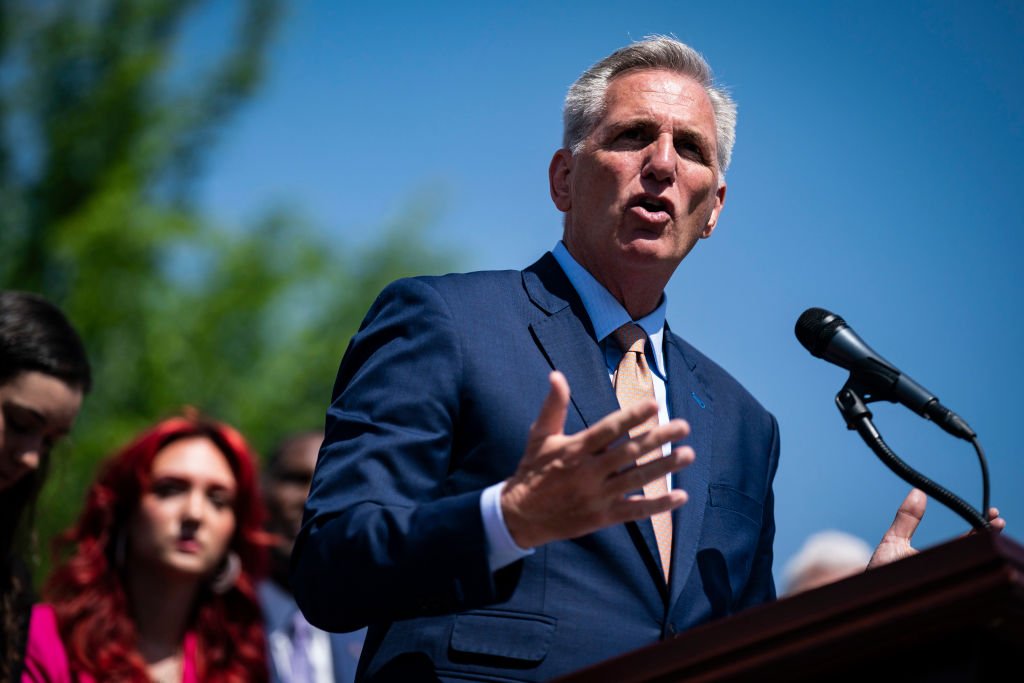Speaker Kevin McCarthy helped himself considerably—and quieted more than a few of his critics—by muscling a debt ceiling plan through the House last week. But the good feelings may recede as the fine print gets more scrutiny. The proposed spending caps in the House-passed bill are too low to be taken seriously, and would be risky for the country if they were.
McCarthy’s plan—the Limit, Save, Grow Act of 2023—pairs a $1.5 trillion increase in the limit on federal borrowing, or a suspension through March 2024 if new borrowing at that point is less than $1.5 trillion, with numerous GOP budget and policy priorities. Among other things, the bill would repeal many climate-related subsidies enacted in last year’s Inflation Reduction Act. The Congressional Budget Office (CBO) estimates the full plan, including reduced interest payments on the debt, would lower federal borrowing over 10 years by $4.8 trillion (a Rules Committee modification produced modest changes to the original estimate).
While these savings are significant, they remain small relative to the size of the nation’s budget problem. Even if the House bill were to become law—a highly unlikely scenario—the government would still borrow $15.5 trillion over the next decade and run an annual deficit in 2033 of nearly $2.2 trillion, or 5.6 percent of GDP. For context, the average deficit from 1970 to 2008 was 2.4 percent of GDP.
Further, most House bill’s savings are questionable, as they come from imposing extremely constraining caps on discretionary accounts. Of the $4.8 trillion the CBO estimated in deficit reduction for the overall plan, $3.2 trillion comes from lower spending on annually approved appropriations.
In general, reinstating caps on discretionary spending is a good idea. They are a tested and effective tool for budgetary control. They also recognize that the only way to counter the political pressures that push appropriated spending up is with an overall limitation. Congress is not good at making discrete cuts to individual programs; every account has a champion, and political dealmaking gives them leverage. There needs to be an aggregate limit—a budget—that forces Congress to curb its collective appetite for whole categories of budget accounts.
The first caps were created in the 1990 budget agreement between then-President George H.W. Bush and a Democratic Congress. With extensions, they were a prominent feature of the budget process from 1991 to 2002, with separate limits on defense, international affairs, and non-defense accounts. The last stretch of government surpluses—over the period 1998 to 2001—coincided with mostly effective enforcement of these spending caps over a full decade.
After 2002, the George W. Bush administration and Congress allowed the caps to expire. Budget decisions during the years that followed–which were dominated by the response to the 9/11 attacks–were more ad hoc and unconstrained.
In 2011, after Republicans took control of the House, then-Speaker John Boehner worked with President Obama to reinstate caps on appropriated spending as part of the Budget Control Act, which was a fallback plan when the “grand bargain” they sought fell through. The BCA caps worked, but only briefly, as the levels set beyond the first years proved to be well below what was politically achievable. In retrospect, the BCA caps produced very little lasting discipline.
Unfortunately, the caps in Speaker McCarthy’s plan look more like those of the BCA era than the original ones of the 1990s. That is not entirely a surprise–McCarthy is responding to the same pressures and constraints that Boehner encountered. With entitlement savings off the table, there are few options for reducing the deficit without raising taxes. The only way the House GOP caucus can claim big spending cuts without touching Social Security and Medicare is by imposing broad caps on appropriations that allow them to avoid naming specific targets.
Pushback will come soon enough, however, as the implications of the GOP proposal become more widely understood. For 2024, the plan would return total appropriation spending to 2022 levels—nearly $1.7 trillion—across both defense and non-defense spending. But two years of inflation will have eroded the purchasing power of funding provided in 2022 considerably. Relative to CBO’s baseline for 2024, the cap in the McCarthy plan represents a 12 percent cut.
Further, unlike the caps of the 1990s, the GOP plan makes no distinction between defense and non-defense spending, which is startling given the state of world affairs. With Russia’s attack on Ukraine and China’s stated intention of challenging the U.S. in a number of arenas, national security experts will certainly be alarmed at the prospect of Congress moving forward with such deep cuts in the defense budget.
And there is no question the cuts would be very deep. The GOP plan would take the level proposed in 2024 and increase it by 1 percent each year through 2033. With inflation remaining above 2 percent for the entire period, each year would require real cuts in spending authority. If the share of total discretionary spending between defense and non-defense remained unchanged over this period, total defense funding would be below 3 percent of GDP every year from 2024 to 2033 and would fall to just 2.3 percent of GDP in 2033. Funding for the military has not been that low at any point in the post-World War II era. Indeed, from 2000 to 2022, annual defense outlays have averaged 3.6 percent of GDP.
The story for non-defense appropriations is similar. The aftermath of the COVID pandemic saw substantial increases in spending, some of which can be reduced going forward. But if non-defense accounts retain their current share of the total discretionary budget, the aggregate allocation to these programs and agencies would fall below the norm of recent memory. By 2033, outlays for this slice of the budget would be just 2.6 percent of GDP, or a full percentage point below the average over the period 2000 to 2022. Total spending on all appropriations would be just 4.9 percent of GDP, which is well below the levels that have prevailed for decades.
The House GOP’s apparent willingness to approach a default is also alarming. It is important to bring more discipline to the federal budget, but it is not more important than retaining full confidence in the government’s commitment to pay all of its bills on time and without unneeded drama. The fact that most of the GOP’s planned savings would come from imposing caps requiring yet-to-be-specified cuts is an indication that the actual fiscal benefits of the House-passed measure would be far below what is advertised and certainly not worth risking a default.
Wishing the GOP would pull back from its doomsday rhetoric does not absolve the Biden administration of responsibility. The Democrats lost control of the House in the 2022 midterm elections. The price that the president must pay is some concession to the wishes of the party that is now in control of half of Congress. That should be possible without either side feeling like it had to capitulate.
A good starting point would be a negotiation over reasonable caps on discretionary appropriations for 2024 and 2025. There should be separate limits for defense and non-defense spending, and a recognition that providing military and economic assistance to Ukraine is an urgent national priority that most members in both parties support. With those parameters stipulated, the country’s elected leaders might be able to assemble a debt limit plan that is actually a modest net gain for sound governance.






Please note that we at The Dispatch hold ourselves, our work, and our commenters to a higher standard than other places on the internet. We welcome comments that foster genuine debate or discussion—including comments critical of us or our work—but responses that include ad hominem attacks on fellow Dispatch members or are intended to stoke fear and anger may be moderated.
With your membership, you only have the ability to comment on The Morning Dispatch articles. Consider upgrading to join the conversation everywhere.